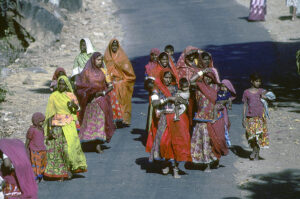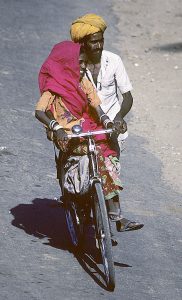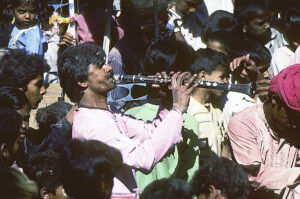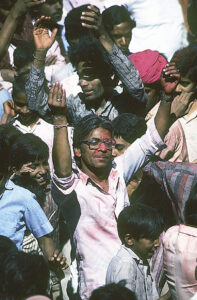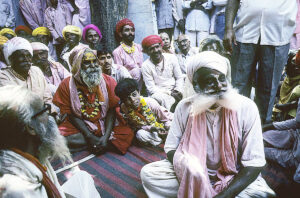Kaj Halberg - writer & photographer
Travels ‐ Landscapes ‐ Wildlife ‐ People
India 1991: Attending Hindu festivals in Rajasthan

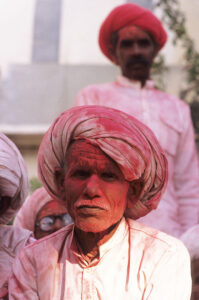
Udaipur was founded in 1559 during the reign of Maharana Udai Singh II, the ruler of Chittorgarh, further north. Chittorgarh, situated in a flat tableland, was vulnerable to attacks from the Maharana’s enemies, notably Muslims, who had conquered parts of northern India. Following the emergence of artillery warfare in the 16th century, Udai Singh decided to move his capital to a more secure location, choosing Ayad.
However, as Ayad was prone to flooding, he decided to establish his new capital on a ridge east of the Pichola Lake, and to protect the new city from attacks, he ordered a wall, 6 km long and with seven gates, to be built around the city. Today, Udaipur is a treasure trove of Mewar architecture, notably a number of palaces, of which two were built on islands in the lake.
The history of the fierce Rajputs is related on the page Travel episodes – India 1986: “His name is Muhammed!”
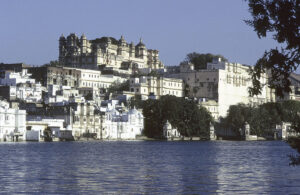
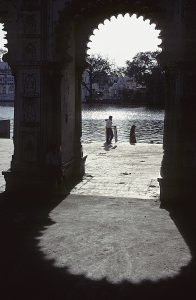
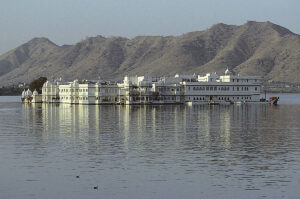
Some days later, we get on friendly terms with an elderly Indian, Sohan Lal, a sparkling and talkative man around 60 years of age, who kindly invites us to join him in his roomy car to go further north in Rajasthan, to the small town of Charbhuja, where an interesting festival is taking place – in reality a continuation of the Holi Festival, which was celebrated ostentatiously about a week prior.
Holi is a spring festival, dedicated to the Hindu god Krishna, and to the victory of good over evil – a gay festival, in which people, regardless of caste, pelt each other with red, yellow, purple, or green powders, or with water, dyed with these powders. For this reason, Holi has been dubbed ‘Festival of Colours’.
In Charbhuja and surroundings, Holi is a very important festival, lasting no less than 15 days, during which period the various villages of the area are host by turns. Sohan Lal intends to go to his ancestral area to participate in the conclusion of Holi.
Ann-Christine, Hans, and I gladly accept his offer to take us along. After the festival, we intend to make a visit to Khumbalgarh Wildlife Sanctuary, situated near Charbhuja. We have heard that you can stay in a former Maharaja palace near the sanctuary.

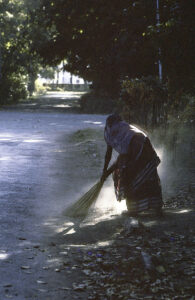
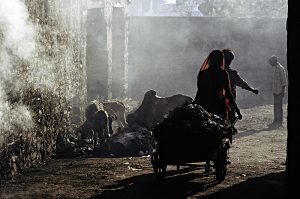
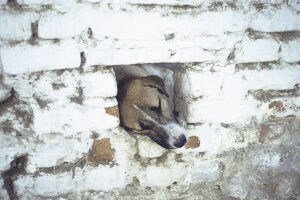
Worried, my Swedish friends ask Sohan Lal, if he thinks that we’ll get our share of the dye, but he assures us that he will be able to find a safe place for us.
We park the car at the outskirts of town and walk along narrow lanes to a Vishnu temple in the centre. The streets are covered in a thin layer of red powder, with a splash of purple and green here and there, and everybody has had his or her fair share of the dye on clothes, face, and hair.
Sohan Lal brings us to a house opposite the temple. From its balcony, we are able to watch the fun and take as many pictures as we wish. The square in front of the temple is packed with people, and several men are dancing on a small platform, accompanied by drums and tablas (small finger drums). At the entrance to the temple, the air is filled with red dust, as a couple of young men throw dye on each and every person, entering or leaving the temple.
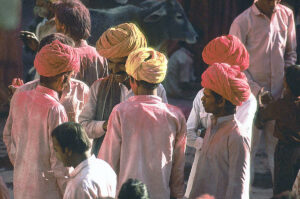
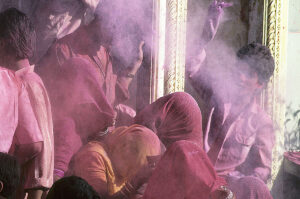
The girl across the street is still throwing of dye at me, and now I think I must take action. I run down into the street, grab a little powder from a person, passing by, and throw it into the face of the girl. However, this action only has the effect that everybody starts throwing dye at me from all directions. My camera is hidden under my T-shirt, but nevertheless it looks awful, covered in powder. Luckily, it still works!
The merry crowd invites me to join them into the temple, where I am met by a fantastic sight. Dressed in their colourful saries (which have become even more colourful due to the dye), the women are seated along one side of the temple, whereas the men are seated along the other side, almost all wearing a red or yellow turban, and a dress which was originally white, but now has numerous red, pink, or green stains from the dye.
The atmosphere here is indeed intense. The temple is resounding with music from drums and cymbals, and red dust fills the air. My spirits are high, when I rejoin Hans and Christine, but on seeing me, they declare that I look terrible!


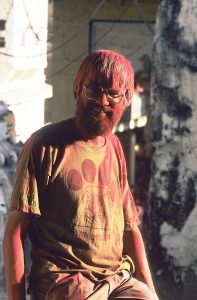
I didn’t have time to take a bath, so I am still smeared in red dye from the fun in Charbhuja. This is probably the reason why the owner of the hotel, a son of the former Maharaja, rather arrogantly informs us that we can have a room for three persons – for the tidy sum of 350 Rupees! And our dinner is going to cost 50 Rs. per person. However, it is now pitch-dark outside, so, reluctantly, we accept his terms.
A servant brings us to a very spartan room, which, anywhere else in India, would have cost 10 Rs. per person. The distance to the bathroom is 20 m, the drain in it is blocked, and the toilet is unable to flush.
Despite the primitive facilities, we have a refreshing shower, before we go to have our dinner. Prior to the meal, we have a conversation with the Maharaja’s son, sitting in a much nicer room. Yes, he can easily arrange a car for us to go into the reserve at 6 o’clock. His knowledge of the wildlife of the sanctuary is quite good, as his father used to own the area, which was his private hunting ground.
He mainly addresses the Swedes, as my humble self seems to be below his sphere of interest, despite the fact that in the meantime I have had a bath and am now wearing clean clothes. However, he pricks up his ears, when the Swedes, untruthfully, inform him that I am collecting information to write a guide book on Rajasthan. (Well, in fact Søren is collecting information for a travel guide book on India, but it was never his intention to include Kumbhalgarh in it.)
Now the attitude of the young Maharaja suddenly changes. Earlier, he has confided in us that he needs larger focus on his hotel, as he doesn’t have enough income to maintain his palace. He brings us to a beautiful and tasteful room, which is adorned with an enormous canopy bed, offering us this room for the same price as for the dump we were given earlier. Somewhat carelessly, he admits that the dump is in fact part of the staff quarters!
Our meal is served in a huge hall, adorned with weapons and family photos, yellowed with age. The food is nothing to write home about, but we are very hungry and fall to.
As the day dawns, a beautiful landscape emerges through the mist: steep, forest-clad mountains and valleys, created by rivers through millennia.
Our Ambassador is a coughing wreck, and on a steep road it almost comes to a standstill. We must leave the car and proceed on foot the rest of the way to a Forest Rest House, beautifully situated at a reservoir, in which various birds are feeding, including little cormorant (Phalacrocorax niger), pond heron (Ardeola grayii), and striated heron (Butorides striata). Along the road, we notice birds like grey junglefowl (Gallus sonneratii), plum-headed parakeet (Psittacula cyanocephala), and slender-billed vulture (Gyps tenuirostris). We fail to observe any mammals.
Rather disappointed with the result of our trip, we return to the palace, where we complain to the hotel owner. He maintains, however, that it had been impossible to rent a jeep, which we find rather odd, as we saw several of the kind in Ghanerao the day before. Following further discussion, he agrees to charge us only a total of 300 Rs. for our stay, including the meal.

This evening, he informs us, in the nearby town of Sevantri, a huge festival is going to take place in a Vishnu temple, celebrating the conclusion of the old Hindu year and the beginning of 2049, according to the Hindu calendar.
Off we go in his car to Sevantri, and beneath a huge banyan fig (Ficus benghalensis), he now commences to cook enormous amounts of food. People, passing us on their way to a nearby temple, are very friendly, greeting us with nice smiles. Having enjoyed a delicious meal, we rest beneath the fig tree for some time, talking with Sohan Lal.
After dark, we head for the Vishnu temple, where the New Year is celebrated with music and dancing. To the immense relief of my Swedish friends, they learn that no more throwing of dyes is going to take place!
Inside the temple, a group of men are performing a stick dance, in which the rhythm is dictated by a man who beats an irregular measure on a drum, while another man is beating a regular measure on a large brass cymbal, once in a while accompanied by a huge, twisted horn, producing a braying sound.
Initially, the speed is slow, and the men, in twos, walk in circles, in and out between each other, beating their two sticks simultaneously on their partner’s sticks, and on the sticks of the men behind them and in front of them. This procedure produces a rhythm, which can be expressed thus: ’clack’ – step – ’clack’ – step – ’clack-clack-clack’.
The speed is gradually increased, and the dance gets wilder and wilder, as more men join the ring, which now occupies most of the temple hall. Spell-bound, we join the rhythm, stomping our feet and clapping our hands.
Sohan Lal informs us that the purpose of this dance is to produce sweat on the entire body, allowing the accumulated sins of the old year to leave the body.
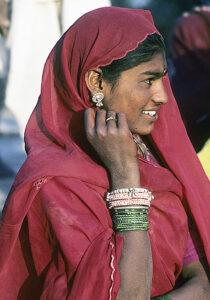
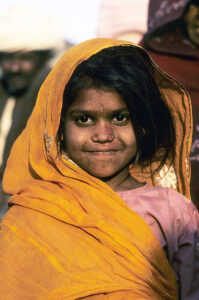
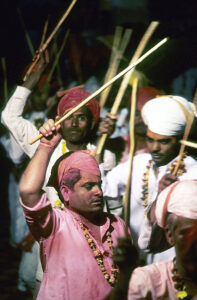
We participate in a puja (worship), marching past the priest who hands out sugary water to everybody, of which a small part is drunk, and the rest smeared into your hair.
Tired, but happy, we return to the ashram, where we immediately fall asleep, despite a noisy puja taking place in the Hanuman temple across the road.
The following morning, numerous people arrive from near and far, wearing their best finery, to celebrate New Year in the Hanuman temple. At the entrance, people are dancing around, accompanied by music from various instruments. The noise produced is incredible.
As usual, we are invited inside the temple, where several elderly priests receive us most courteously. It is indeed pleasant to participate in a festival, where you don’t feel as an intruder, but as a welcome guest!
